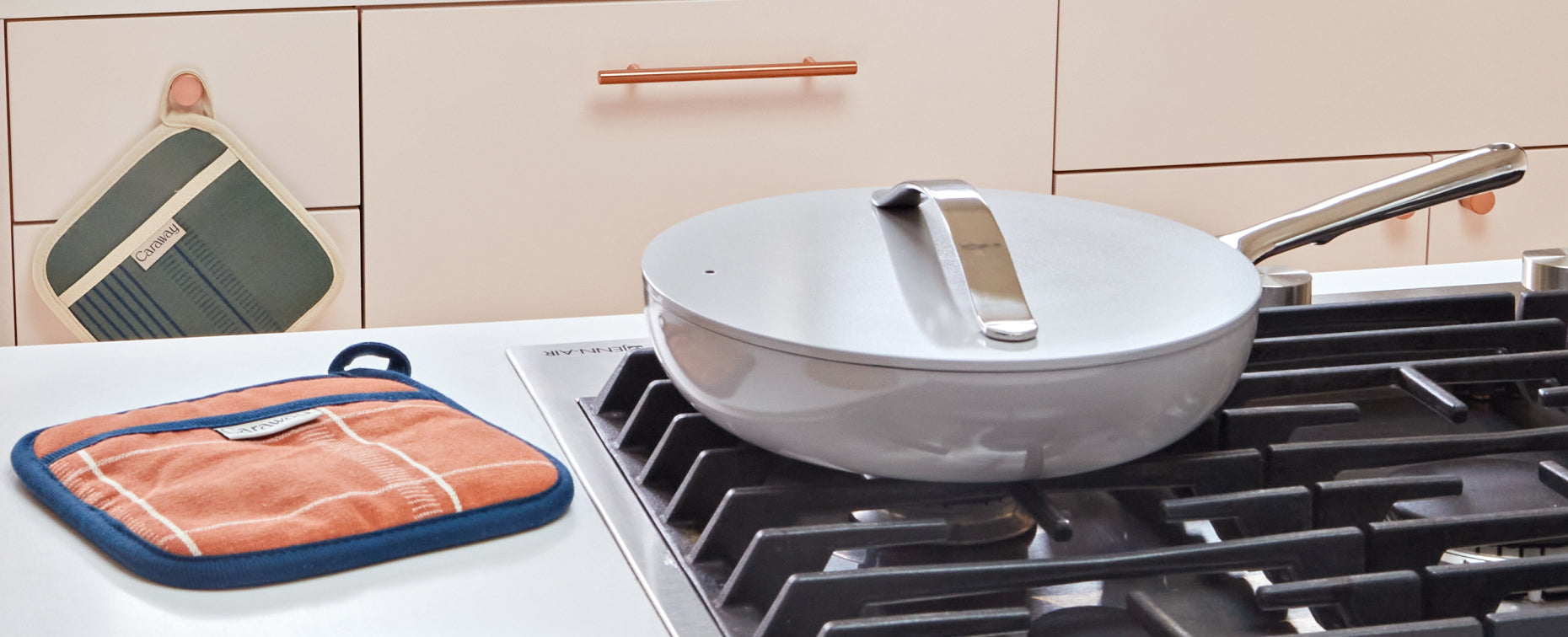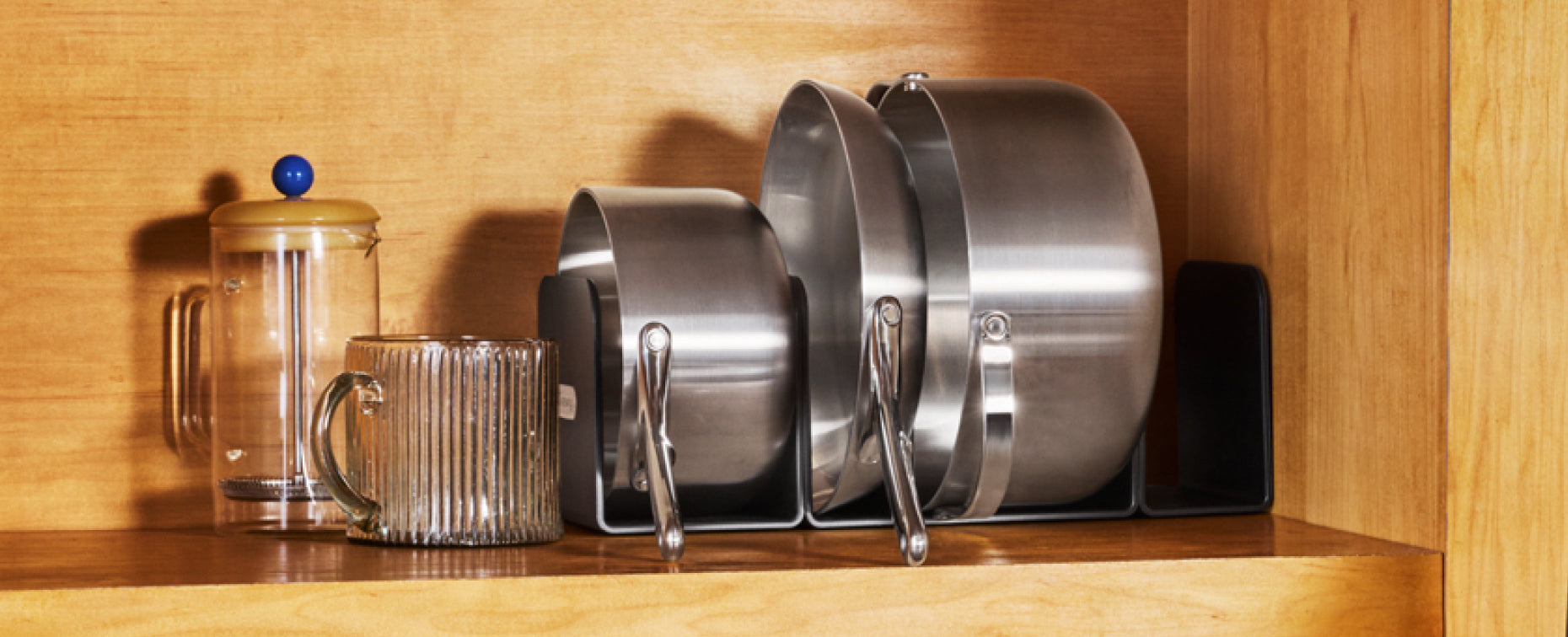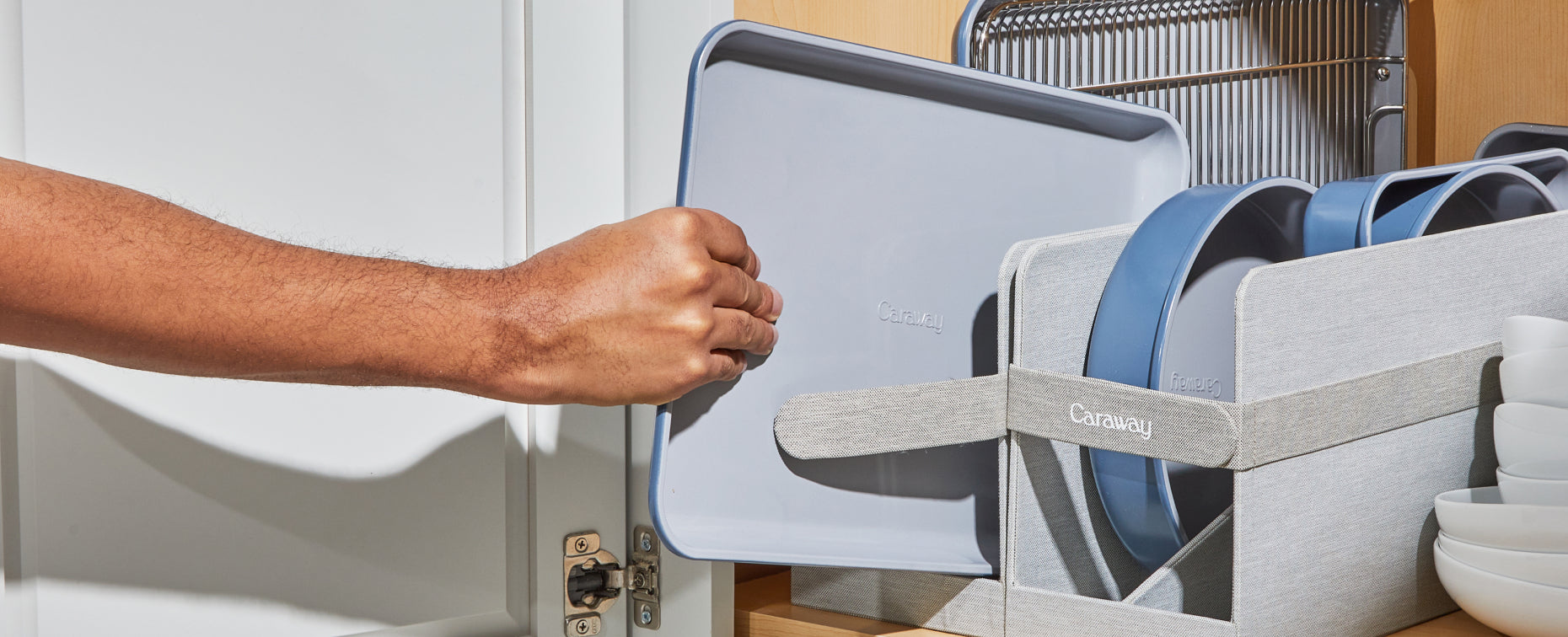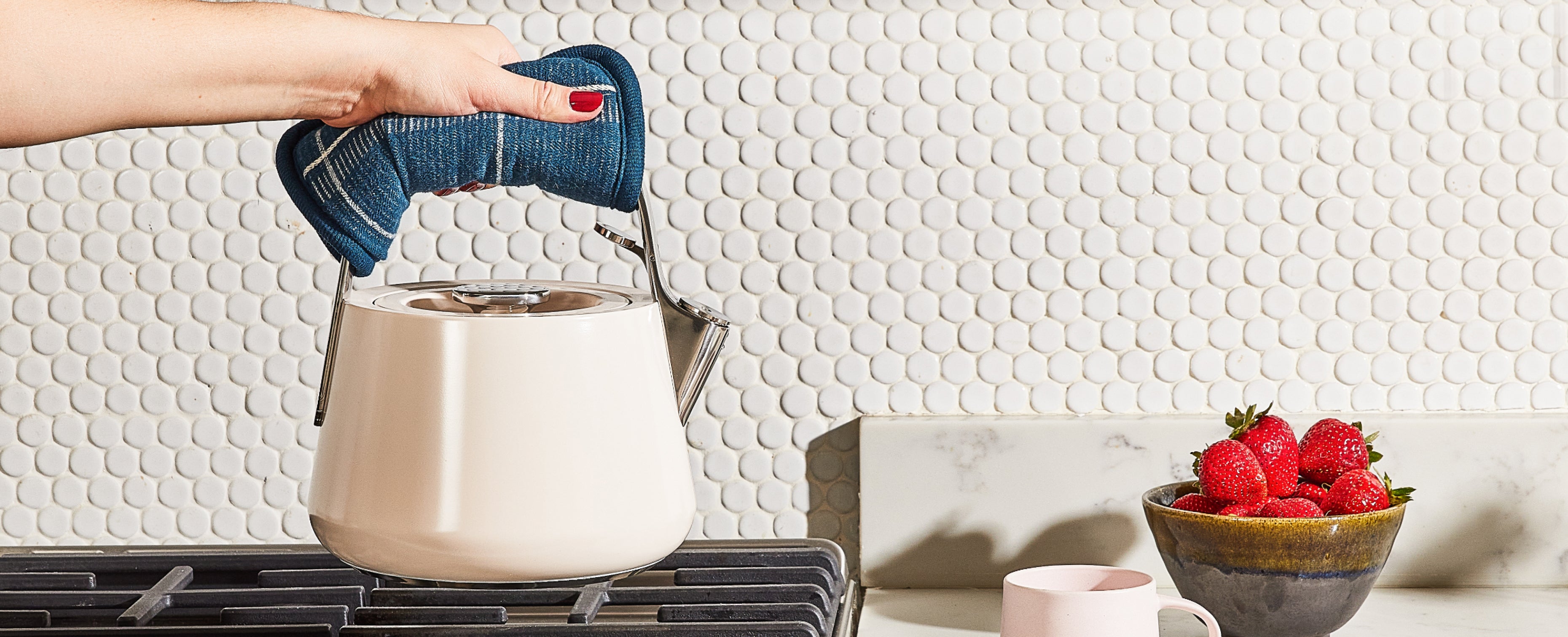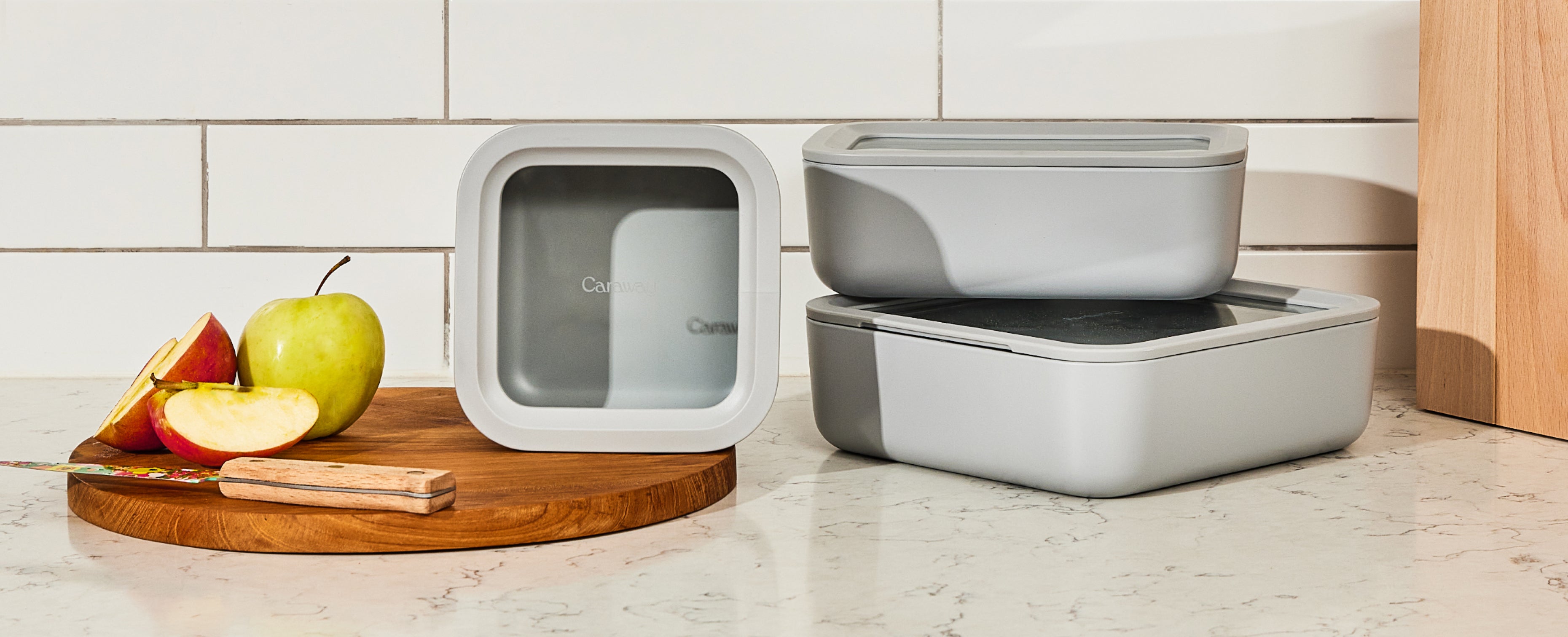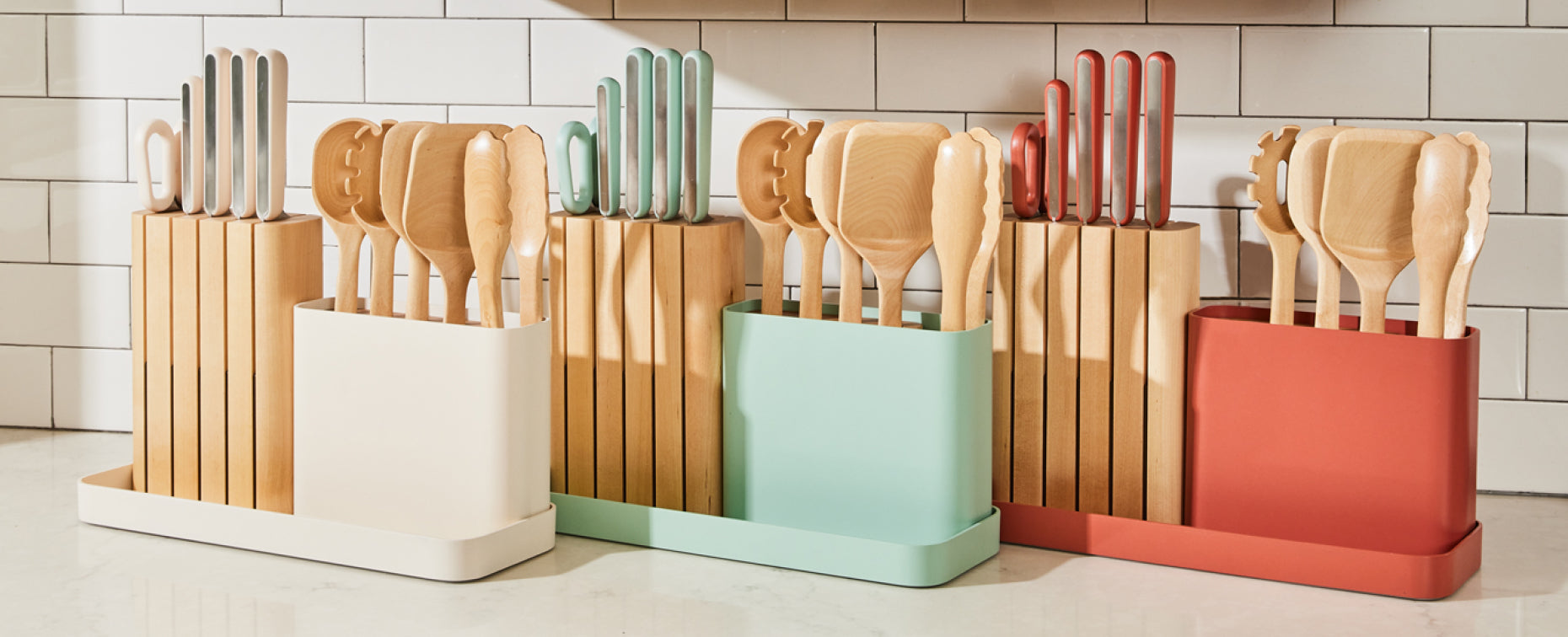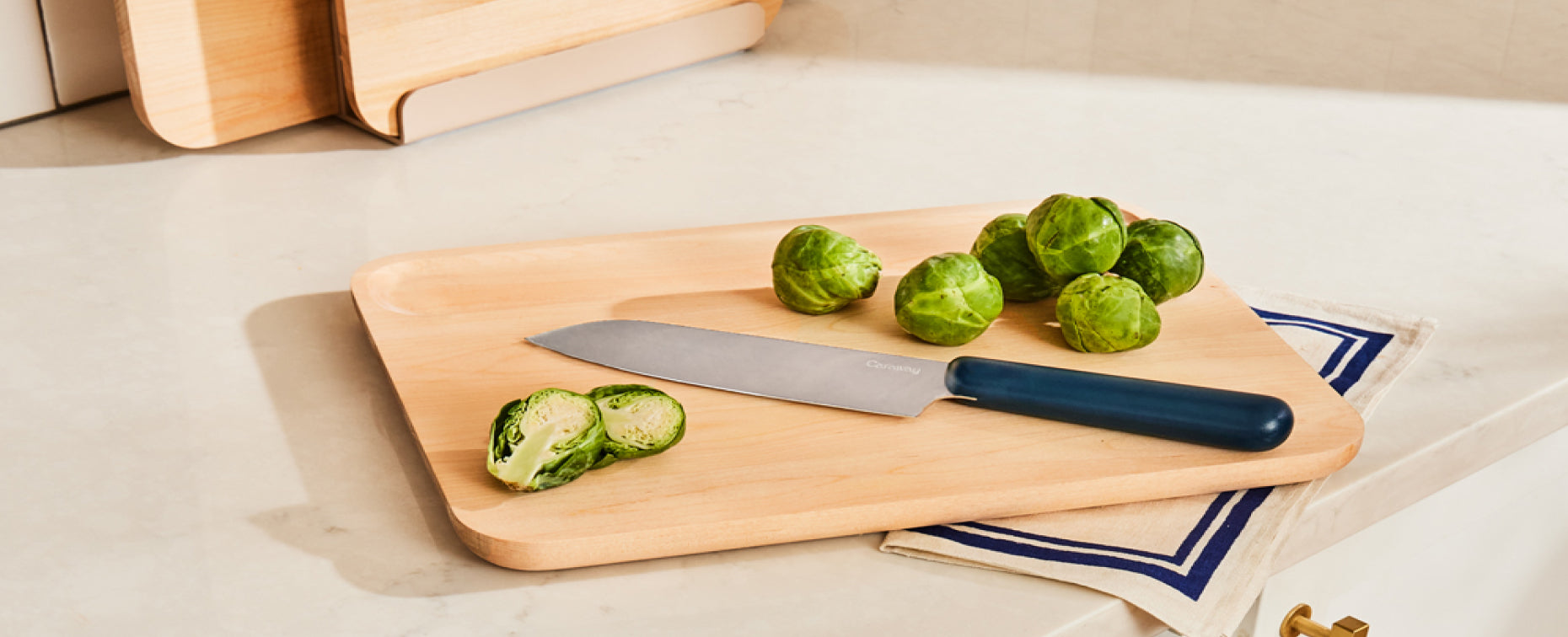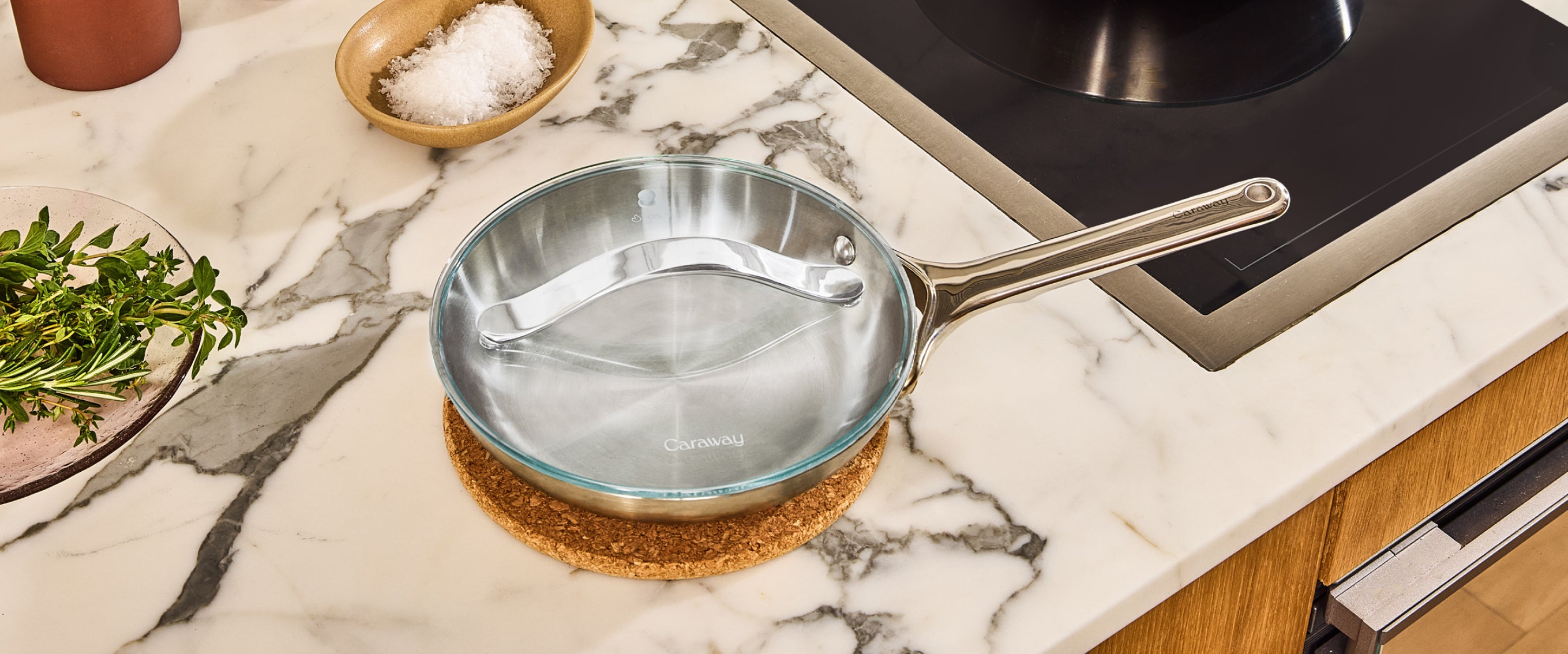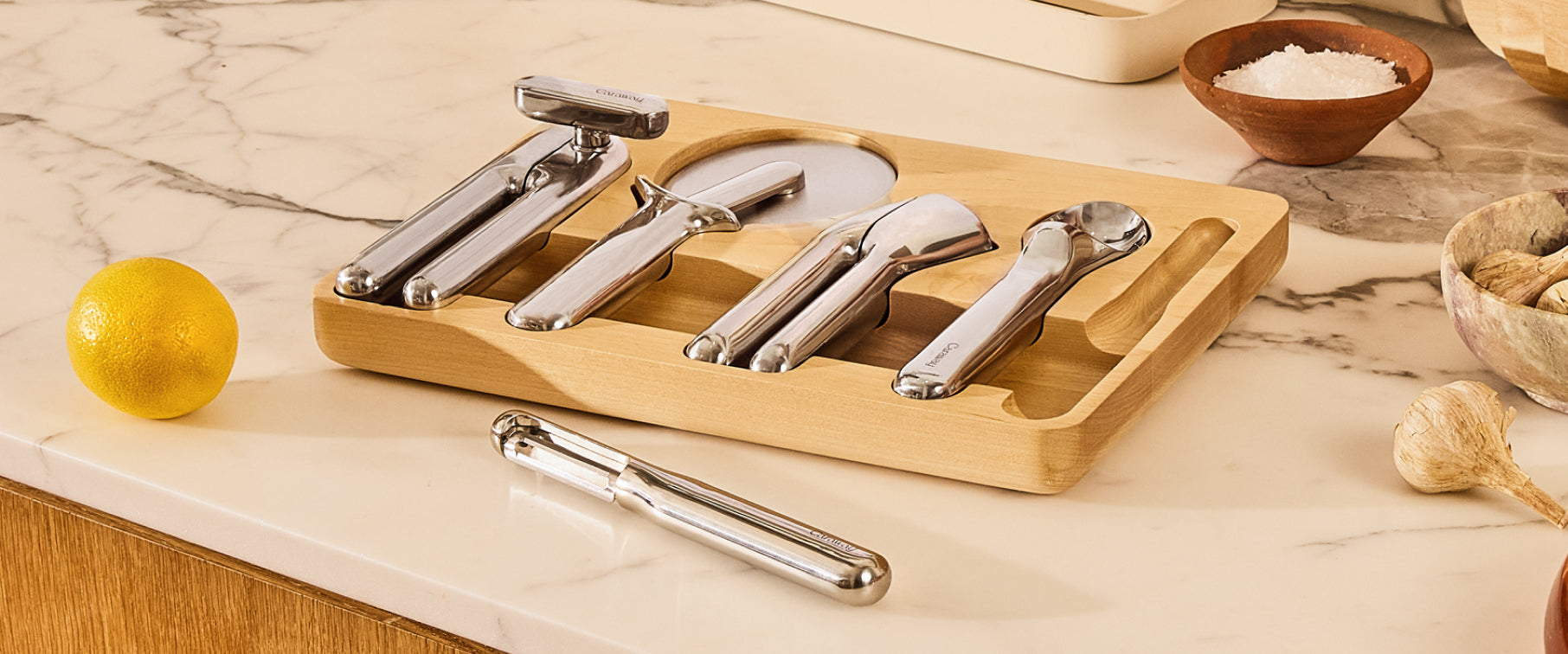Ceramic-Coated Cookware

USE ON LOW TO MEDIUM HEAT ONLY

STOVETOP AGNOSTIC

550°F MAX OVEN HEAT

HANDWASH ONLY
Before Cooking
-
QUICK DIP
Hand wash your pans with warm, soapy water to remove any dirt or debris left over from the manufacturing and shipping process. -
CLEAN AS A WHISTLE
Wipe dry with a soft, non-abrasive dish towel to avoid scratching. The bottom surface of your pan should be dry before touching a burner. -
SKIP THE SEASONING
Ceramic comes naturally non-stick, so no need to season your pan beyond a dash of oil. -
READY FOR THE HEAT
Pre-heat for up to 90 seconds on low to medium heat only before adding oil. Avoid leaving an empty pan on a hot burner, unless over very low heat.
During Cooking
-
BURNIN' UP
Ceramic can hold heat more efficiently than traditional pans, so use pans on low to medium heat when cooking. Overheating can wear away the non-stick coating. -
AU NATURAL
Your food will effortlessly glide on your ceramic pans, so less is more when it comes to oil or butter. 1-2 tablespoons is more than enough to lightly coat the entire pan surface. Allow 20-30 seconds to pre-heat before you add food. -
DITCH THE SPRAYS
Avoid using oil sprays or cooking aerosols for greasing pans to preserve the naturally slick coating. -
NO POINTY EDGES
Metal utensils with rough edges may damage your non-stick coating. Stick to wooden, silicone, plastic, or nylon products. Always be sure to cut or dice food on a separate surface and not inside your pan. -
GRACEFUL LANDING
Carefully place pans on and off stovetops. Sliding across metal stovetops may damage the steel base.
After Cooking
-
TIME TO COOL DOWN
Let your cookware cool completely before running cold water over its surface to avoid thermal shock (meaning it might crack—yikes!). Your pans can withstand extreme temperatures on both ends of the spectrum, but sudden and significant changes can reduce their lifespan. -
NO DISHWASHER, NO PROBLEM
Our non-stick coating makes cleaning a breeze. Save time and water with a gentle scrub to keep your pans in optimal condition. -
SQUEAKY CLEAN
Clean the cooking surface with warm, soapy water and a non-abrasive sponge or dishcloth until the pan is spotless before storing. For stains on the exterior of the pan, you may use a stronger sponge (we suggest a wool sponge) with a high-strength detergent. -
BREAKING BONDS
If food gets stuck onto the surface, fear not! Simmer soapy water over a low heat then gently scrape away with a sponge or non-abrasive scrubber. Rinse and repeat if needed.
Have More Questions?
Visit Our FAQ Page
Stainless Steel Cookware

STOVETOP AGNOSTIC

NON-TOXIC STAINLESS STEEL

5-PLY CONSTRUCTION
Before First Use
-
QUICK DIP
Hand wash your pans with warm, soapy water to remove any dirt or debris left over from the manufacturing and shipping process. -
CLEAN AS A WHISTLE
Wipe dry with a soft, non-abrasive dish towel to avoid scratching and dry spots. The bottom surface of your pan should be dry before touching a burner. -
LET'S TALK PREP
Add oil or butter to your pan to create a slick surface for your food. Bring ingredients to room temperature before placing them into your heated pan (too cold food tends to stick to a warm pan!). -
READY FOR THE HEAT
Preheat on low to medium heat before adding oil. Avoid leaving an empty pan on a hot burner. -
DISCOVER YOUR WINNING RECIPE
For your first few uses, monitor your heat setting to gauge your stovetop & oven’s heat efficiency and adjust recipes as needed. Food should sizzle when it hits the pan as an indication of proper heating.
During Cooking
-
BURNIN` UP
Caraway's 5-ply stainless steel cookware can hold heat more efficiently than traditional pans, so use yours on low to medium heat when cooking. Overheating can cause food to stick to the pan! -
AU NATURAL
Add oil or butter into your pan to lightly coat the entire surface. Allow time to pre-heat before you add food. -
DITCH THE SPRAYS
Avoid oil sprays or cooking aerosols. Instead, use butter or liquid based oils to best preserve your cookware. -
SALT WHEN HOT
Wait until the food inside your pan is nice and hot before adding salt to prevent calcium deposits from forming “pit” marks on the surface of your cookware. -
NO POINTY EDGES
Utensils with rough edges (like metal knives, whisks, or spatulas) will damage your stainless steel pans, so stick to soft wooden, silicone, plastic, or nylon products. -
GRACEFUL LANDING
Carefully place pans on and off stovetops. Sliding across metal stovetops scratch the pan’s exterior.
After Use
-
TIME TO COOL DOWN
Let your cookware cool completely before running cold water over its surface to avoid thermal shock (meaning it might crack—yikes!). -
NO DISHWASHER, NO PROBLEM
Save time and water with a gentle scrub to keep your pans in optimal condition. Avoid using the dishwasher as it can affect the longevity of your cookware. -
SQUEAKY CLEAN
Clean the cooking surface with warm, soapy water and a non-abrasive sponge or dishcloth until the pan is spotless before storing. For tougher stains, you may use a stronger sponge with a high-strength detergent.
Have More Questions?
Visit Our FAQ Page
Bakeware

FREE OF PTFE, PFOA, LEAD & CADMIUM

550°F MAX OVEN HEAT

HANDWASH ONLY
Before Baking
-
QUICK DIP
Hand wash your bakeware with warm, soapy water to remove any dirt or debris left over from the manufacturing and shipping process. -
CLEAN AS A WHISTLE
Wipe dry with a soft, non-abrasive dish towel to avoid scratching. The full top and bottom surface of your bakeware should be fully dry before being put in the oven. -
SKIP THE SEASONING
Ceramic comes naturally non-stick, so no need to season your bakeware. -
READY FOR THE HEAT
Heat your oven to your desired temperature before adding in your bakeware. Avoid putting empty bakeware into the oven without any food on it. -
FRIENDLY FIRE
Your bakeware does not play well with open flames (stovetops, grills, campfires), so stick to only using in the oven.
During Baking
-
DISCOVER YOUR WINNING RECIPE
Our bakeware’s ceramic coating allows for even heat distribution. For your first few uses, closely monitor your heat setting to dial in on the perfect baking temperature or oven time and adjust recipes as needed. -
LINE IT UP
Our ceramic surface is designed for easy release when fully coated with flour, or a light amount of oil or butter, before food is added, per recipe instructions. For a speedy clean up, lining with parchment paper will also maintain its non-stick quality. -
DITCH THE SPRAYS
Avoid oil sprays or cooking aerosols. Instead, use butter or liquid based oils to best preserve the slick coating. -
NO POINTY EDGES
Utensils with rough edges will damage your non-stick coating, so stick to soft wooden, silicone, plastic, or nylon products. Avoid using metal entirely. Do not cut baked goods while they are in the pan. -
GRACEFUL LANDING
Sharp metal edges may damage the exterior base coating, so place carefully on and off oven grates and stovetops. -
TOO HOT TO HANDLE
When placing your bakeware in or out of the oven, use a pot holder, oven mitt, or dishtowel as the pans and handles will get hot to the touch. -
HOT & POPPIN`
It is normal for bakeware to slightly “warp” and make a popping sound in the oven due to the heat. Don’t worry—our bakeware’s reinforced rim will ensure it will flatten once cooled. -
BAKED, NEVER BROILED
Bakeware is not to be used under an oven’s broil setting, beyond 550°F, or in a microwave. -
ALL FIRED UP
When you remove your bakeware from the oven, place your pans on the cork trivets provided to protect your kitchen countertops.
After Baking
-
TIME TO COOL DOWN
Let your bakeware cool completely before running cold water over its surface to avoid thermal shock (meaning it might crack—yikes!). Your bakeware can withstand extreme temperatures on both ends of the spectrum, but sudden and significant changes can reduce their lifespan. -
A HANDY WAY TO CLEAN
Our non-stick coating makes cleaning up by hand a breeze. Save time and water with a gentle scrub to keep your bakeware in optimal condition. -
COME CLEAN
Clean the cooking surface with warm, soapy water and a non-abrasive sponge or dishcloth until the pan is spotless before storing. For stains on the exterior of the pan, you may use a stronger sponge (we suggest a wool sponge) with a high-strength detergent. -
BREAKING BONDS
If food gets stuck onto the surface, fear not! Cover the baking pan with 2 tablespoons of baking soda and 1 cup vinegar. Let the mixture sit for 30 minutes. This will release stuck-on food so that it can be easily wiped away. Once the mess is gone, wash the baking pan with mild dish soap. -
BROWNING POINTS
Similar to your favorite cast iron pan, browning is natural and bound to occur with regular baking and use (it builds character)—but it’s nothing some baking soda and vinegar can’t remove. -
DRY IT OUT
Dry with a soft, non-abrasive dish towel or place inside your bakeware storage to air dry completely. -
LOAD IT UP
For storing, we recommend utilizing your storage caddies to keep your bakeware in top condition. If stacking, place towels, trivets, or a protective sheath between pan surfaces to minimize direct contact.
Have More Questions?
Visit Our FAQ Page
Tea Kettle

USE ON LOW TO MEDIUM HEAT ONLY

STOVETOP AGNOSTIC

HANDWASH ONLY
Before First Use
-
QUICK DIP
After removing the caution sticker from the handle, hand wash your kettle with warm, soapy water to remove any dirt or debris left over from the manufacturing and shipping process. -
CLEAN AS A WHISTLE
Wipe dry with a soft, non-abrasive dish towel to avoid scratching. The bottom surface of your kettle should be dry before touching a burner. -
FILL `ER UP
Never place an empty kettle on a hot burner or allow your kettle to boil dry without any water in it. This will damage your kettle and potentially your stovetop.
During Use
-
MAXED OUT
Fill the kettle with water up to the Max Fill line located inside the kettle. Overfilling the kettle will lead to spillage when boiling. -
STICK TO THE STOVE
Never place your kettle on a burner larger than its base, or in an oven, microwave, or dishwasher. -
GRACEFUL LANDING
Sliding across stovetops may damage your kettle or your stovetop (especially glass or induction). Always carefully lift it on and off. -
BURNING` UP
Our kettle boils water more efficiently than traditional kettles, so low to medium heat is all you need. Lower heat will increase the longevity of your kettle and avoid causing damage to your stovetop. -
WHISTLEBLOWER
For proper whistling, make sure to tightly place the lid on your kettle. -
THE 20 SECOND RULE
When you hear the whistle indicating the water has finished boiling, turn off your burner and wait approximately 20 seconds until the water ceases to boil. Do not pour boiling water from the kettle. -
TOO HOT TO HANDLE
Always use the provided pot holder or mitt when removing the kettle from the burner or pouring, and do not remove the lid until fully cooled. Handles and lid will be hot to the touch and take 30 minutes to cool down after boiling. -
LOCKED & LOADED
Push the handle lever down until you feel a click or the spout is fully raised and locked into place in order to begin pouring. -
POUR WITH CAUTION
To avoid spilling boiling water (not ideal for tea time), do not pour from the kettle unless the lid is closed and locked. -
ALL FIRED UP
When setting down a hot lid or kettle, place on top of a pot holder or trivet to protect your kitchen countertops.
After Use
-
TIME TO COOL DOWN
Always let your kettle cool completely (about 30 minutes) before allowing it to touch cold water in order to avoid thermal shock (meaning it might crack—yikes!). -
NO DISHWASHER, NO PROBLEM
All you need is a gentle scrub to keep your kettle in optimal condition. Never wash your kettle in the dishwasher. -
SQUEAKY CLEAN
Clean your kettle with warm, soapy water and a non-abrasive sponge until the kettle is spotless before storing. For tougher stains, try a wool sponge with strong detergent. -
LIKE MAGIC
For any stains that can’t be removed with your sponge, there is nothing a melamine cleaning sponge can’t solve.
Have More Questions?
Visit Our FAQ Page
Food Storage

DISHWASHER SAFE

MICROWAVE, OVEN, REFRIGERATOR, AND FREEZER SAFE

FOOD SAFE MATERIALS
Before First Use
-
QUICK DIP
Hand wash all containers with warm, soapy water to remove any dirt or debris left over from the manufacturing and shipping process. -
CLEAN AS A WHISTLE
Wipe dry with a soft, non-abrasive dish towel to avoid scratching. -
FRIENDLY FIRE
Your ceramic-coated glass containers do not play well with open flames, so stick to the microwave or oven.
During Use
-
NO POINTY EDGES
Metal utensils may damage the non-stick coating, so stick to soft wooden, silicone, plastic, or nylon products. -
GRACEFUL LANDING
Sliding across surfaces may damage the container's exterior coating. Always carefully lift and set down, and avoid dropping. -
TOO HOT TO HANDLE
Always use a pot holder, oven mitt, or tea towel when removing your containers from a hot oven or microwave. -
ALL FIRED UP
When removing from the oven or microwave, always set the hot container down onto a trivet, pot holder, or tea towel to prevent damage to your countertops. -
TIME TO CHILL
Do not take containers directly from the freezer to a hot oven or microwave (this could cause your containers to crack—yikes!). Allow frozen food to thaw before reheating. -
ALWAYS SAVE SPACE
When using in a freezer or refrigerator, allow space in the containers for liquids or food to expand. -
COOL IT DOWN
Allow hot food contents to completely cool before sealing and storing.
Microwave & Oven Use
-
EASY HEATING
Follow your microwave’s instructions on heat settings and cooking time when defrosting, cooking, or reheating foods. Overheating for extended periods of time will damage your containers. -
TOP IT OFF
Remove the lids whenever microwaving your food containers. -
PARTY OF NONE
Do not microwave an empty container. -
SKIP THE PLASTICS
Avoid using plastic wrap on or inside the container whenever microwaving. Plastic wrap can potentially heat, melt, and then adhere to the container walls. -
PRE-OVEN PREP
Only the ceramic-coated glass containers can be used in the oven up to 450ºF, so be sure to remove all lids and inserts before they enter your oven. -
READY FOR HEAT
Preheat your oven to your desired temperature before inserting your food containers. Avoid putting empty ceramic-coated glass containers into the oven without any food inside. -
DISCOVER YOUR WINNING RECIPE
For your first few uses, closely monitor your heat setting to dial in on the perfect cooking temperature or oven time and adjust recipes as needed. -
BAKED, NEVER BROILED
Food prep containers are not to be used under an oven’s broil setting.
After Use
-
TIME TO COOL DOWN
Let your containers cool completely if you use the microwave or oven before installing the lid or running cold water over its surface to avoid melting or thermal shock, which can lead to cracks. -
CALL IN THE CLEANING COMMITTEE
Wash your containers in the dishwasher on a normal wash cycle for a thorough, deep clean in between uses. -
SQUEAKY CLEAN
Whenever hand washing, clean your containers with warm warm, soapy water and a non-abrasive sponge until they are spotless before storing. For tougher stains, try a wool sponge with strong detergent. -
DRY IT OUT
Dry with a soft, non-abrasive dish towel or set containers in your storage racks to air dry completely. -
MAKE IT THROUGH
When drying, remove the lids from each container so that air can dry the inside of your containers. Remember to remove the gasket on your container lids for a thorough dry. -
LOAD IT UP
For storing, we recommend utilizing your storage racks to keep your containers in mint condition. If stacking, place a protective sheath between container surfaces to minimize direct contact.
Have More Questions?
Visit Our FAQ Page
Prep-Set

FSC-CERTIFIED BIRCH WOOD

PREMIUM GERMAN STEEL BLADES

HANDWASH ONLY
Before First Use
-
QUICK DIP
Hand wash all knives and utensils with warm, soapy water to remove any dirt or debris left over from the manufacturing and shipping process. -
SPICK & SPAN
Wipe the inside surface of the tray and bin with a damp cloth before setting them on your countertop. -
CLEAN AS A WHISTLE
Dry all items with a soft, non-abrasive dish towel to avoid scratching after washing. -
SKIP THE TREATMENT
Your Wood Utensils, Knife Block, and Utensil Bucket come pre-treated, so no need to oil or wax these items before or after use.
How To Care For Your Utensils
-
HAND WASH ONLY
Always hand wash your utensils immediately after use with warm soapy water. Ensure you wash both sides of the utensil to avoid uneven drying. Steer clear of submerging your utensils in water or dish soap so they do not warp. -
STAND UP STRAIGHT
Warping and cracking can occur as wood contracts and expands. When drying, stand your utensils upright on your counter or wipe down with a dish towel to remove excess water prior to storing. -
CALL IN THE CLEANING COMMITTEE
To disinfect, sprinkle the affected area with kosher salt, squeeze lemon juice over it, and use the lemon to rub the mixture over the area. Allow the paste to dry, and gently wipe off. Alternatively, you can use a solution of 25% distilled white vinegar and 75% water. Do not use bleach or baking soda on your utensils as they may cause damage.
How To Care For Your Knives
-
CUT WITH CAUTION
Avoid surfaces that can dull or damage your knives such as fine china, marble, granite, tile, porcelain, stainless-steel countertops, and glass. We recommend using wooden or quality plastic cutting boards for the ideal stable surface. -
HAND WASH RECOMMENDED
All you need is a gentle scrub to keep your knives in optimal condition. Avoid dishwashing or submerging in water as it can affect the longevity of your knives. -
SO LONG, PATINA
To minimize patina when cutting highly acidic foods, occasionally rinse the blade clean in between chops. -
SHINING STAR
Over time, stainless steel knives lose their shine. To restore, rub white vinegar, lemon juice, or a food-safe stainless steel cleaner over the blade with a dishcloth. -
STAY SHARP
For blade maintenance, regularly sharpen your knives before use and store them in the provided knife block. Keeping knives loose in a drawer or dishwashing will dull the blades and risk accidentally getting cut. -
ON THE FLIPSIDE
Scraping food off a cutting board with your blade will dull it over time. Instead, flip the knife around and use the topside when scraping.
Have More Questions?
Visit Our FAQ Page
Cutting Board Set

FSC-CERTIFIED BIRCH WOOD

MINERAL OIL & WAX FINISH

HANDWASH ONLY
How To Care For Your Boards
-
HAND WASH ONLY
Always hand wash both sides of your cutting board immediately after use with warm soapy water. Don’t submerge your board in water or place it in a dishwasher. If you’re cutting something that doesn’t need a rinse, stay clear of water to extend the longevity of your board. -
STAND UP STRAIGHT
Warping and cracking can occur as wood contracts and expands. When drying, always stand your board upright on your counter or in the organizer to allow it to dry evenly. -
TREAT `EM RIGHT
To extend each board’s longevity, apply mineral oil with a clean cloth once a month. Let oil set for a few hours before wiping dry with a cloth. For an extra shine, apply food-grade beeswax once dry. Do not use vegetable or nut-based oils on your board. -
SQUEAKY CLEAN
To disinfect stains, squeeze fresh lemon juice directly onto your board with a sprinkle of kosher salt, using the lemon to rub the mixture across the entire area. Once dry, gently scrape off. Alternatively, use a solution of 25% distilled white vinegar and 75% water. Do not use bleach or baking soda on your board.
Have More Questions?
Visit Our FAQ Page
Glass Lid

DISHWASHER SAFE

425°F MAX OVEN HEAT

TEMPERED GLASS
How To Care For Your Glass Lid
-
READY FOR HEAT
Our glass ids were designed to go from the stove to the oven and can handle a maximum temperature of 425°F. -
TIME TO COOL DOWN
Allow glass ids to completely cool before running cold water over their surfaces to avoid thermal shock (which will affect the performance and longevity of your lids). -
HANDY TO HANDWASH
Our glass lids are dishwasher safe. When hand washing, we recommend cleaning with warm, soapy water and a non-abrasive sponge until spotless.
Have More Questions?
Visit Our FAQ Page
Kitchen Gadgets

HANDWASH ONLY

EASY TO CLEAN
How To Care For Your Kitchen Gadgets
-
SQUEAKY CLEAN
Rinse with warm water and dish soap immediately after use to prevent items from sticking. Towel dry and allow to dry in a dish rack. We recommend letting the products dry fully before placing them in the included storage rack. -
HAND WASH ONLY
The high heat of dishwashing and harsher washing cycles may lead to pit corrosion, wear sharp edges more quickly, and cause other issues. -
TOO HOT TO HANDLE
Do not place close to the oven, freezer, or refrigerator. Subjecting stainless steel to extreme temperatures may adversely affect the material properties, leading to corrosion, cracking, or other defects.



